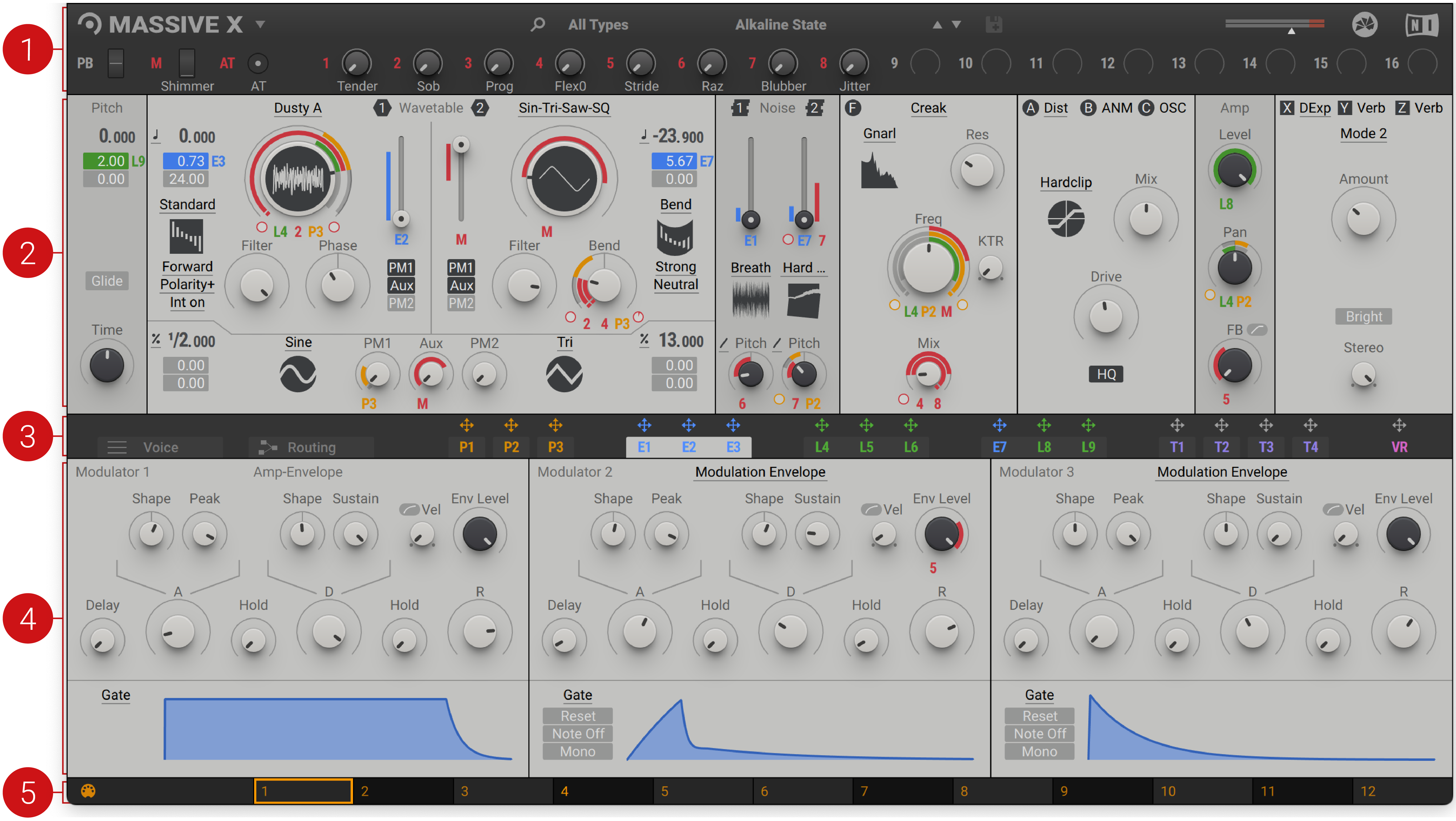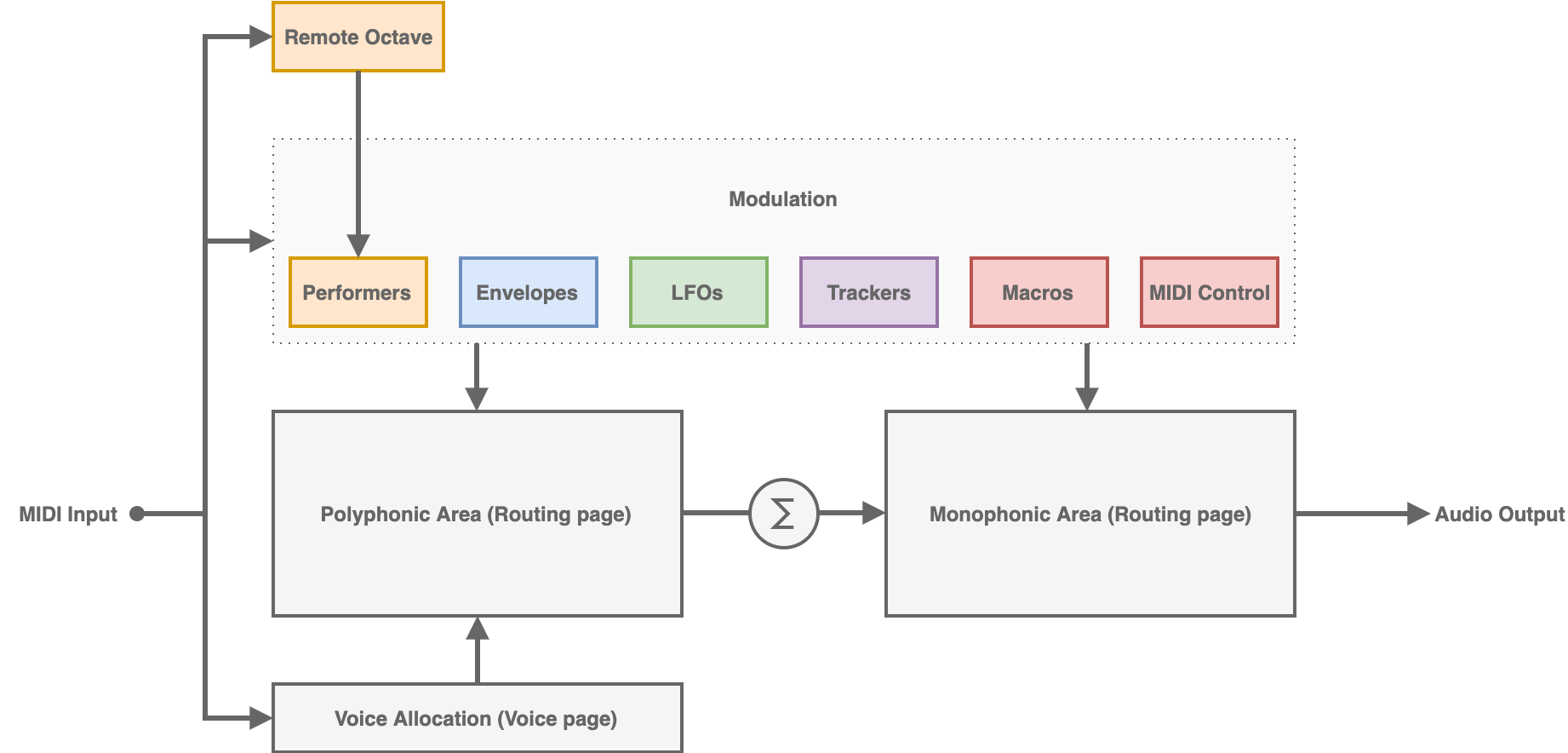Overview of Massive X
Massive X groups related modules and functions in horizontal sections. Find an overview of these sections here.
The Massive X layout consolidates related modules and functions in horizontal sections. These five key sections include:

Header: Find, save, and load presets, monitor output volume, access MIDI controller and Macros that can be assigned to control your sound. This section includes:
Global Controls: Access features including the Settings menu, the Browser, and the Macro controls. Refer to Header Overview.
Browser and Presets: Search for sounds using advanced filtering, and manage your factory and user presets. Refer to Browser and Presets.
Macros: Assign the modulation wheel, pitch bend and aftertouch controls as well as the 16 Macro knobs to a single or multiple parameters of Massive X and build custom sets of shortcuts for easy access or complex modulations. The Macros also give you access to host automation and MIDI control for Massive X parameters. Refer to Macros.
Module panels: Control the generators and processors that are used to create your sound. You can freely connect them in the Routing page to achieve a wide range of synthesis techniques. This section includes:
Global Tune: Access the global tuning and glide settings. Adjust the tuning in semitones and cents and enable the glide effect (portamento). Refer to Global Tune .
Oscillators: Work with two Wavetable oscillators that form the basis for sound generation in Massive X. Explore the collection of wavetables, different Modes of operation, and available controls. Refer to Wavetable Oscillators.
Noise: Use the two noise sources and the custom collection of noise samples to create dramatic textures, percussive elements, and random control voltages. Refer to Noise.
Filter: Select from nine different types of filters that cover a wide range of applications. Balance and correct the tone of a sound, sculpt complex textures, and transform a patch entirely. Refer to Filter.
Insert Effects: The three Insert Effects slots can be loaded with a range of effects modules, including distortion, sample and hold, and various insert oscillators. Refer to Insert Effects.
Amplifier: Control the level and panning of your signal before it enters the Stereo Effects section and adjust the feedback amount of the voice's feedback loop. Refer to Amplifier.
Stereo Effects: Select from a range of time-based, utility, spatial, and saturation effects, with three available effects slots and three different routing options. Refer to Stereo Effects.
Navigation Bar: Select the page you want to view in the editor. The available pages include Voice, Routing, and modulation sources. This section includes:
Modulation: From the navigation bar, you can assign modulation sources to controls by using drag and drop. Refer to Modulation.
Editor: By selecting an editor page in the navigation bar, you can access all the controls and menus of the respective feature. Set monophonic or polyphonic behavior as well as unison and harmonizing on the Voice page, arrange and connect audio modules on the Routing page, or dive deep into any of the modulation sources. This section includes:
Voice page: Refer to Voice Page.
Routing page: Refer to Routing.
Modulation sources: Refer to Modulation Sources.
Remote Octave: Control the contents of the Performers via MIDI. This way you can control the Performers’ complex modulation curves in a playable manner and structure your song. This section includes:
Remote Octave: Refer to Remote Octave.
Basic Concepts
This section introduces basic concepts and key features that are fundamental to Massive X.
A voice consists of all components required by a synthesizer to create the sound of a single note. Massive X is a polyphonic instrument, meaning that it can play multiple voices at the same time. In basic polyphonic operation, each voice corresponds to a note event. For example, when playing a triad chord, three voices will sound simultaneously. Each voice is processed independently, so every note can have different movements and articulation in the sound.

Tip
On the Voice page, you can define how the instrument responds to note events and how they are allocated to the available voices. Expanding on these basic options, advanced Unison and Scale features make it possible to use the voices as tonal clusters and to form complex chords. For more information, refer to Voice Page.
Routing enables you to create or change the signal path of a synthesizer. In Massive X, you can freely route signals between the individual components of a voice, including sound generators and processors. This modular signal path facilitates a wide range of different synthesis techniques, giving you the freedom to design and explore sounds without constraints. You can use and combine techniques like wavetable synthesis, FM synthesis, subtractive synthesis, physical modeling, and various types of waveshaping, or distortion.

Tip
On the Routing page, you can define the structure of the voice in the Polyphonic Area, which contains modules like the Wavetable Oscillators, the Filter, and the Insert Effects. All polyphonic voices are summed and sent to the Monophonic Area with three additional Stereo Effects. For more information, refer to Routing.
Massive X puts a strong focus on the concept of modulation by combining sophisticated modulation sources with an intuitive system for modulation assignment. Modulation adds movement to your sound by changing controls over time. This movement defines the character and expression of a sound as you play it, from the contour of its amplitude, or volume level, to its timbral qualities.

Tip
You can apply modulation sources to any number of parameters directly in the user interface by using drag and drop. Color-coded rings or lines next to controls indicate the modulation source and the amount of modulation applied to the parameter. For more information, refer to Modulation.
Among the available modulation sources are the three Performers, which are specialized sequencers for modulation. They provide a flexible way to apply complex, rhythmical movements to parameters. The Performers can be controlled using the Remote Octave, which allows you to switch between patterns remotely using MIDI notes as key switches, or by selecting one of the 12 patterns using the mouse in the footer of Massive X.

Tip
The Performer's patterns and additional settings can be changed in the Editor by selecting the tabs labeled P1, P2, and P3 in the navigation bar. From there, you can also open the Performer Grid view that provides an overview of all available patterns and their assignment to the Remote Octave. For more information, refer to Performers and Remote Octave.
As additional control sources, Massive X provides a set of 19 Macros including pitch bend wheel, modulation wheel, and aftertouch controls as well as 16 Macro knobs. Each Macro can either take over the full range of a single parameter or control any number of parameters to a varying degree. Also, like any other knob in Massive X the Macros themselves can be controlled using MIDI and host automation from your DAW.

Tip
You can assign Macros to any number of parameters directly in the user interface by using drag and drop. Red rings or lines next to controls indicate the Macro assignment and its amount. For more information, refer to Macros.
Instrument Structure
Massive X is built on an advanced structure that facilitates a high degree of modularity while also enabling optimized signal processing. It is comprised of both polyphonic and monophonic components:
Polyphonic components are processed independently for every single voice you play.
Monophonic components are globally applied to the sum of all polyphonic voices.
The following diagram shows the types of components according to their structural relationships:

The Polyphonic Area contains the modular signal path of the polyphonic voices. It includes a variety of sound generators and processors that you can freely arrange and connect on the Routing page. For more information, refer to Routing.
The Monophonic Area contains the effect chain that is globally applied to the sum of all polyphonic voices. It includes three stereo effects that you can use to process the output of the Polyphonic Area on the Routing page. For more information, refer to Routing.
Modulation consists of various modulation sources and Macros that can be assigned to parameters across the instrument using the unified modulation system. Modulation sources can be monophonic or polyphonic, depending on their type and selected mode, as well as the parameter they are assigned to. Most modulation sources respond to incoming MIDI notes. For example, note events are used to trigger envelopes and reset LFOs. For more information, refer to Modulation and Modulators. In addition, all the continuous parameters (typically in the form of rotary knobs) are available for host automation and MIDI control from your DAW.
Voice allocation distributes the incoming MIDI notes across the available polyphonic voices. On the Voice page, you can manage the behavior of the voices, or transform the MIDI notes to create complex voicings and harmonic layers. For more information, refer to Voice Page.
The Remote Octave provides dedicated control for the Performers, which are specialized sequencers for modulation. The Remote Octave maps incoming MIDI notes to key switches that you can use to access variations of the patterns used by the Performers. For more information, refer to Remote Octave.